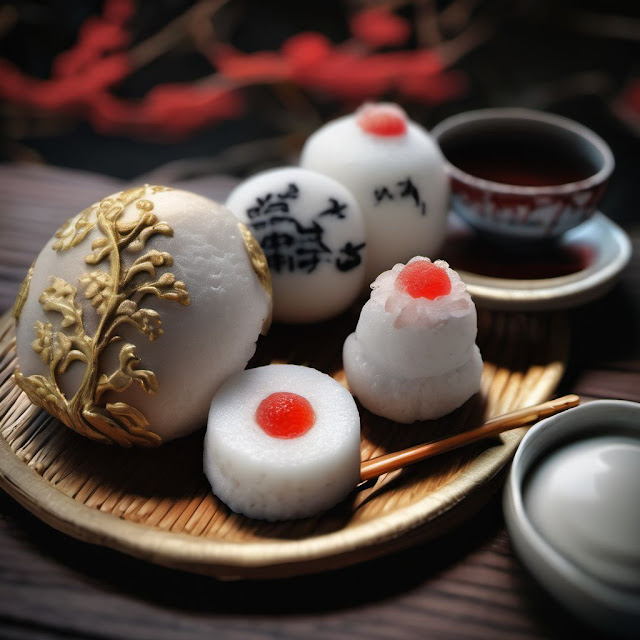Daifuku is a traditional Japanese sweet that is made with rice cake and sweet fillings such as red bean paste. It is also known as mochi and is usually served as a dessert or snack. Daifuku can be found in various flavors such as strawberry, green tea, black sesame, chocolate, and even ice cream.
The process of making daifuku involves steaming glutinous rice flour and then pounding it into a soft, sticky dough. The dough is then cut into small portions, rolled into balls, flattened and filled with sweet fillings. The most popular filling is sweet red bean paste, which is called anko in Japanese. There are other fillings as well, such as fruit jam, chocolate, and cream.
Daifuku is a popular snack in Japan, and it can be found in most convenience stores and supermarkets. It is often served during traditional Japanese events such as the New Year holiday and serves as a symbol of good fortune. In addition, it can also be found in restaurants and cafes, often served with hot green tea.
How to Make Japanese Daifuku Dessert
Ingredients:
- 1 cup glutinous rice flour
- 1/3 cup sugar
- 2/3 cup hot water
- Potato starch or cornstarch
- Sweet red bean paste
Instructions:
1. In a medium bowl, combine the glutinous rice flour and sugar. Use a whisk to combine the two ingredients thoroughly.
2. Add the hot water in a gradual stream while stirring with a spatula. Mix the dough gently until the water is fully incorporated.
3. Once the dough has come together, it is time to knead. Transfer the dough to a clean surface dusted with potato starch or cornstarch.
4. Knead the dough with your hands for about 5 minutes or until smooth, adding more starch as needed to prevent sticking.
5. When the dough is smooth, divide it into 12-16 equal pieces and roll each piece into a ball.
6. Flatten each ball into a small circle.
7. Place a spoonful of red bean paste in the center of the circle.
8. Bring the edges of the dough up and around the paste.
9. Pinch the edges of the dough together at the top to enclose the filling. Shape the dough into a ball.
10. Roll the daifuku balls in potato starch or cornstarch to prevent sticking and place them on a tray lined with parchment paper.
11. Let the daifuku rest for about 10-15 minutes before serving.
Tips:
- Be sure to use glutinous rice flour, which is different from regular rice flour. Glutinous rice flour gives mochi its signature chewy texture.
- Use a fine-mesh strainer to dust your work surface with potato or cornstarch to create a smooth surface for kneading and shaping the dough.
- When pinching the edges of the dough together, make sure it is well-sealed to prevent the red bean paste from leaking out.
Enjoy your delicious homemade daifuku!
Variations of Daifuku
There are many variations of daifuku available, both in Japan and around the world. Some of the most popular variations include:
1. Strawberry Daifuku: This variation uses a whole strawberry as the filling, along with the sweet red bean paste.
2. Matcha Daifuku: Matcha, or green tea powder, is added to the dough to give it a green tea flavor. The filling is usually sweet red bean paste, but it can also be matcha-flavored cream.
3. Yomogi Daifuku: Yomogi, or Japanese mugwort, is mixed into the dough to give it a subtle green color and a slightly herbal flavor. It is usually filled with sweet red bean paste.
4. Mitarashi Daifuku: This variation has a soy sauce-based glaze, which is drizzled over the sweet red bean filling. It is often served during summer festivals in Japan.
5. Chocolate Daifuku: Chocolate is used to fill the sweet rice cakes. It can either be a ganache or a chocolate cream filling.
6. Ice Cream Daifuku: Daifuku is wrapped around a scoop of ice cream. The most popular flavors used are green tea, vanilla, and strawberry.
There are many other variations that use different flavors and ingredients, making Daifuku a versatile treat that can be enjoyed in many different ways.
Heathy Benefits of Daifuku
Daifuku can be a healthy snack when consumed in moderation, as it contains several beneficial nutrients.
1. Fiber: Daifuku is made with glutinous rice flour, which is high in fiber. Fiber is essential for maintaining healthy digestion and can also help to lower bad cholesterol levels.
2. Protein: The red bean paste filling in daifuku is a good source of protein. Protein is essential for building and repairing tissues, and it can also help to keep you full and reduce cravings.
3. Vitamins and Minerals: Daifuku can be made with a variety of fillings, such as fruit or matcha, which are both high in vitamins and minerals. Matcha, for example, is high in antioxidants and can help to promote healthy skin.
However, daifuku can also be high in calories and sugar, depending on the type of filling used. It is best to enjoy daifuku in moderation and as part of a balanced diet.




.jpg)
.jpg)





.jpeg)



0 Comments